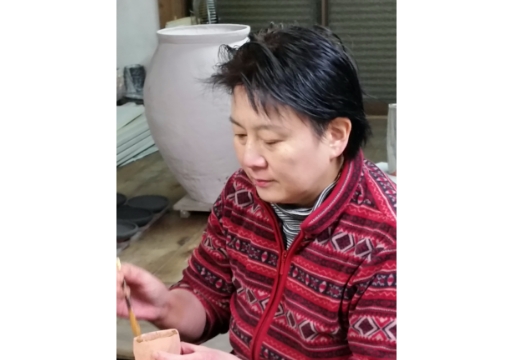Kimata Kaoru
| 1967 | Born in Kagoshima prefecture |
| 1987 | Graduated from Konan Women’s College |
| Apprenticed to Mr. Sakurei Okamoto and others | |
| 1995 | Became independent in Kobe |
| 2008 | Built a climbing kiln in Asago city, Hyogo |
| Regularly hold solo and group exhibitions in | |
| department stores and individual galleries |
| 1967 | 鹿児島 生まれ |
| 1987 | 甲南女子大学短期大学部 卒 |
| 唐津にて修行 | |
| 岡本作礼氏、他に師事 | |
| 1995 | 神戸にて独立 |
| 2008 | 兵庫県朝来(あさご)に登り窯、築窯 |
全国百貨店、個人ギャラリーにて個展、グループ展開催 |

Atmosphere

薪窯のこと 最近は、薪作りの専門業者さんが減り、薪の確保もいよいよ難しくなってきました。 私は木造家屋の解体で出た柱をチェーンソーで定間隔に切り薪割機で割ります。 窯焚き中は当然ながら薪をくべ続けなければ火は落ちてしまう。 重労働です。 温度調節は難しく、温度の上り過ぎで釉薬がとんだり、生地がへたって窯内にくっついて破損したり。 逆に生焼けなど、焼け損じが沢山出ます。 スイッチ一つで窯焚きを完結できる電気窯や、ガス、灯油の窯が主流のこの便利な時代にあって、わざわざ「登り窯」や「窖(あな)窯」などの薪窯を焚き続ける意味は? 明らかに得られるものは、一部の作品にまとう美しい焼上がりの色合いや緋色。 そして炎を肌で感じながら窯焚き自体の時間を過ごし、火の仕組みを知ること。 がむしゃらに薪をくべても温度は上がりません。 炎の色を見ながら、空気の取込み量を調節し、くべる薪の種類やタイミングをはかる。 経験だけが唯一の理解する方法です。
About Kilns with firewood Recently, it is becoming difficult to get firewood due to a decrease of professional suppliers. I cut pillars from dismantled wooden houses at regular intervals using a chainsaw and then chop them with a wood cutter. As you already know, fire will die if you not continuously fed with wood while baking pottery pieces in a kiln. It is such hard work. It is hard to adjust temperature to ensure the color of the glaze disappears, but also prevents pieces from breaking if the temperature is too high. On the other hand, pieces are not baked enough when the temperature is too low. I still cannot bake every piece perfectly. Why do I continue to use “climbing kilns” and “cave kilns” which need firewood when in this day and age there are electronic kilns with buttons that do everything and gas and oil kilns are so popular? Because using traditional kilns allows some pieces to achieve beautiful color conditions and scarlet* which is not possible with a modern kiln. Also spending time experiencing fire first hand helps me to understand the mechanism of it. The temperature does not rise even you put in a lot of wood at once. To control the temperature, you observe the color of the flame, adjust the amount of air intake, and decide when to add different kinds of wood. Experience is the only way to understand this process. *scarlet… Iron and/or components of ash react to a part of ceramics where is not covered with glaze to color red.
